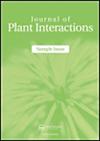黄萱草对萱草锈病抗性机制的比较转录组分析
IF 3.3
3区 生物学
Q2 PLANT SCIENCES
引用次数: 0
摘要
黄花菜(萱草)是中国许多地区重要的经济作物。萱草锈病是由萱草锈病引起的一种主要病害。研究了2个柑桔抗感品种叶片的锈病情况。利用转录组测序和防御酶活性分析相关基因在0、72、144、192和288 h后的差异表达,揭示黄颡鱼对锈病的反应机制和筛选相关抗性基因。结果表明,Ph侵染后72h是判断耐感品种差异的关键时间点。deg在苯丙素生物合成、植物-病原体相互作用、植物激素信号转导和MAPK信号通路中显著富集。TFs WRKY33和CYP98A是与黄螺旋藻抗病反应密切相关的关键基因。本研究首次对黄颡鱼进行了大规模的转录组学分析。本文章由计算机程序翻译,如有差异,请以英文原文为准。
Comparative transcriptome analysis of the resistance mechanism of Hemerocallis citrina Baroni to Puccinia hemerocallidis infection
Hemerocallis citrina Baroni (daylily) is an important cash crop in many regions of China. Daylily rust caused by Puccinia hemerocallidis (Ph) is a major disease in H. citrina. Rust infection on the leaves of two resistant and susceptible varieties of H. citrina was examined. Transcriptome sequencing and defense enzyme activity were used to analyze the differential expression of related genes after 0, 72, 144, 192, and 288 h, to reveal the response mechanism of H. citrina to rust infection and screen-related resistance genes. The results suggested that 72 h after Ph infection was the key time point for determining differences between resistant and susceptible varieties. DEGs were significantly enriched in phenylpropanoid biosynthesis, plant–pathogen interaction, plant hormone signal transduction, and the MAPK signaling pathway. TFs WRKY33 and CYP98A are key genes closely related to the disease-resistance response of H. citrina. This study is the first large-scale transcriptomic analysis of H. citrina.
求助全文
通过发布文献求助,成功后即可免费获取论文全文。
去求助
来源期刊

Journal of Plant Interactions
PLANT SCIENCES-
CiteScore
5.30
自引率
6.20%
发文量
69
审稿时长
>12 weeks
期刊介绍:
Journal of Plant Interactions aims to represent a common platform for those scientists interested in publishing and reading research articles in the field of plant interactions and will cover most plant interactions with the surrounding environment.
 求助内容:
求助内容: 应助结果提醒方式:
应助结果提醒方式:


